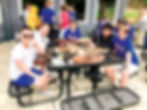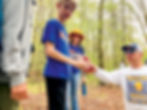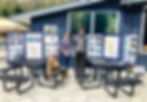Squadron Line students visit Ski Sundown for salmon release
- jfitts0
- Jul 30, 2025
- 6 min read
Written and Photographed by Maria G. O’Donnell
Staff Writer
It never rains for Salmon Release. That was the consensus of those who have been bringing the program to Ski Sundown in New Hartford for over 10 years. After a foggy, soggy start, the sun broke through on May 2, setting the stage for Simsbury’s Squadron Line School sixth graders’ annual Salmon Release Program.
Four classes spent the day rotating between five activities, or stations, most of which focused on salmon behavior and life cycle. New this year were visits from representatives of the Metropolitan District Commission of CT (MDC) and CT Dept. of Energy and Environmental Protection (DEEP).
Once again, Simsbury High tech ed teacher, Dave Palinkas, participated as the salmon release guide at Ratlum Book. Previously a sixth-grade teacher at Squadron, Palinkas launched the program when he first started at the elementary school years ago, and has been asked to return yearly to continue what he does best at the event: assist students’ send-off of the minnow-sized baby salmon, called fry.
Current sixth-grade teacher, Carrie Creech, noted, “This is his thing; we wanted him here.” Yet with the two 20-year-old, 30-gallon classroom tanks starting to fail, and replacing them incredibly expensive, the salmon element of the event may be canceled next year. A curriculum change will focus on weather and water.
But the future sixth grade will still come to Ski Sundown. “They’ve always been so supportive,” Creech said of the ski resort. They generously admit the Squadron Line group off-season at no expense. Creech also credited science teachers Katie Bunel and Emily Noll for maintaining the tanks in their classrooms. In early January, they received 200 second stage, partially developed “eyed” salmon eggs from the CT River Salmon Assoc. for each tank. The eggs hatched around mid-February, and about 300-350 salmon survived from there.
Creech noted that Bunel was the lead teacher for the Salmon Release event and that “she oversaw everything.” She added that Noll “did training with the organization that gives us the salmon,” and Bunel “went to professional development to take care of everything.”
Bunel credited the many hands that contributed. “None of this is possible without parent volunteers – we need extra bodies to keep kids engaged. I have to give a shout out to the MDC and to DEEP, who brought different animals for the kids to explore. Ski Sundown is not even open today. They’re very accommodating. We’re so lucky they’re really close and let us use their facility at no cost.”
As for the students, the four classes rotated through five stations, most of which were salmon- or water-themed. Creech’s class was scheduled for the Great Salmon Race first. Two teams had to dribble a ball soccer-style between cones, jump rope four times, step through a few hula hoops, tag the cone at the end, and rush back to the next teammate. Creech said, “This represents the obstacles salmon must deal with during migration.”
On the note of migration, the class’s next activity was “Come Back Home,” the Smell Station, located at the bunny slope. This would imitate the migratory route that leads salmon to and from their Ratlum Brook home base, since salmon find their way home by smell, called imprinting.
Five separate groups were given five different scents (for example, lavender) that would represent their home scent. A blindfolded team member would sample the smell from a cup and have to navigate through five rows of cups with the rest of the team, keep smelling the cups to find the home scent, and move to the next level of cups, duplicating tracking the scent of their home river.
More migratory discovery came with the actual Salmon Release station. At his famed post at Ratlum Brook, Palinkas addressed Creech’s class, “Why are we doing this? This species was wiped out in Connecticut during the Industrial Revolution when they used dams to power factories. There was no electricity.”
Eventually, government officials removed the dams, making the river more suitable to anadromous fish, which “are born in fresh water, lay eggs, grow here for three years, then go to the ocean,” said Palinkas. He explained their migratory path from Ratlum Brook to the Farmington River, then CT River, Long Island Sound, and up the Northeast coast to Greenland. “There they get fat eating shrimp and fish,” he said. “Your salmon think they’re being born today – they’ll smell the river, then live in Greenland.”
When they want to start a family, they return to where they were born. “They sniff their way back here,” Palinkas explained. “This is where they’ll have babies and continue the cycle.”
He went on to describe the salmon stocking process – not an easy one – as there’s much to beware of. He urged students to “come up with a good name, but don’t get too attached. Sadly, it will probably die. This is how much your salmon might return.” Palinkas squeezed his hands together to form the tiniest pinhole. Still, he encouraged, “Statistically, they might return. There is a chance – that’s why we do this.”
Palinkas warned of one of the worst flying predators: the kingfisher, camouflaged and in hiding. He told them, “Four or five years ago a kid named his fish after his grandfather. The bird ate his grandfather. Look up for a kingfisher.”
He went on to warn of the brook trout, which is “extremely well-camouflaged. They line up for little salmon. You won’t be able to see trout. Stomp hard on the ground, and the trout thinks you’re a bear and takes off. And if you think your salmon is dead, it’s just playing dead. Trout don’t like them dead; they’re like a cat and like to chase salmon.”
Where do you put your salmon? “Do not chuck it in the water,” Palinkas advised. “It doesn’t like to get thrown like a baseball. Look for an eddy – no, not your cousin, Eddie – but the space behind a rock. And don’t put it into a ripple. That’ll carry it into the mouth of a brook trout.”
Then it was time to be handed their baby salmon. “I won’t give you one till you give it a good name,” Palinkas reminded. Students called out names like Georgie, Link, Reginald, Gregory, Jim Bob & Jared (twins), and Jim Bob IV (the popular name of the day). When someone named his “Sushi,” Palinkas played a “Shame!” song on his cell phone.
Once the salmon were set free in their new home, Creech’s class attended the new “Water Works” MDC presentation about local reservoirs, water treatment, and forestry. Senior Project Manager Lindsay Strole and Forester Dan Lawrence discussed the Barkhamsted and Nepaug Reservoirs’ billions of gallons of water that gets treated and supplied to surrounding towns.
Strole said, “It’s important to keep the water clean and protect the watershed. Dan takes care of the land.” Lawrence added, “There are 30,000 acres of watershed we keep healthy and diverse. The forest is the best water filter: The rain hits the leaves, and [trees] prevent erosion, keeping sediment from the reservoir.” The forest is also maintained to provide proper habitats for wildlife.
On the wildlife note, Creech’s class went to their final station of the day with CT DEEP Master Wildlife Conservationist volunteer Peggy Lareau. She said her job is to maintain habitats that “provide food, water, shelter and space – the same as you. Habitat management is the road to success. A habitat is a neighborhood for animals.”
She described beavers as “keystone species. If you pull that out, the whole system breaks down and creatures that come don’t anymore.”
Four tables were lined with animal skins, skulls, and footprint molds. Lareau went to each table to ask students what type of animal each pelt was from. As she held up a coyote skin, a student exclaimed, “There’s a bear!” Way, way up high on the Stinger Slope, sure enough, a medium black bear hurried into a cluster of trees.
This time, it wasn’t The Yeti! VL




